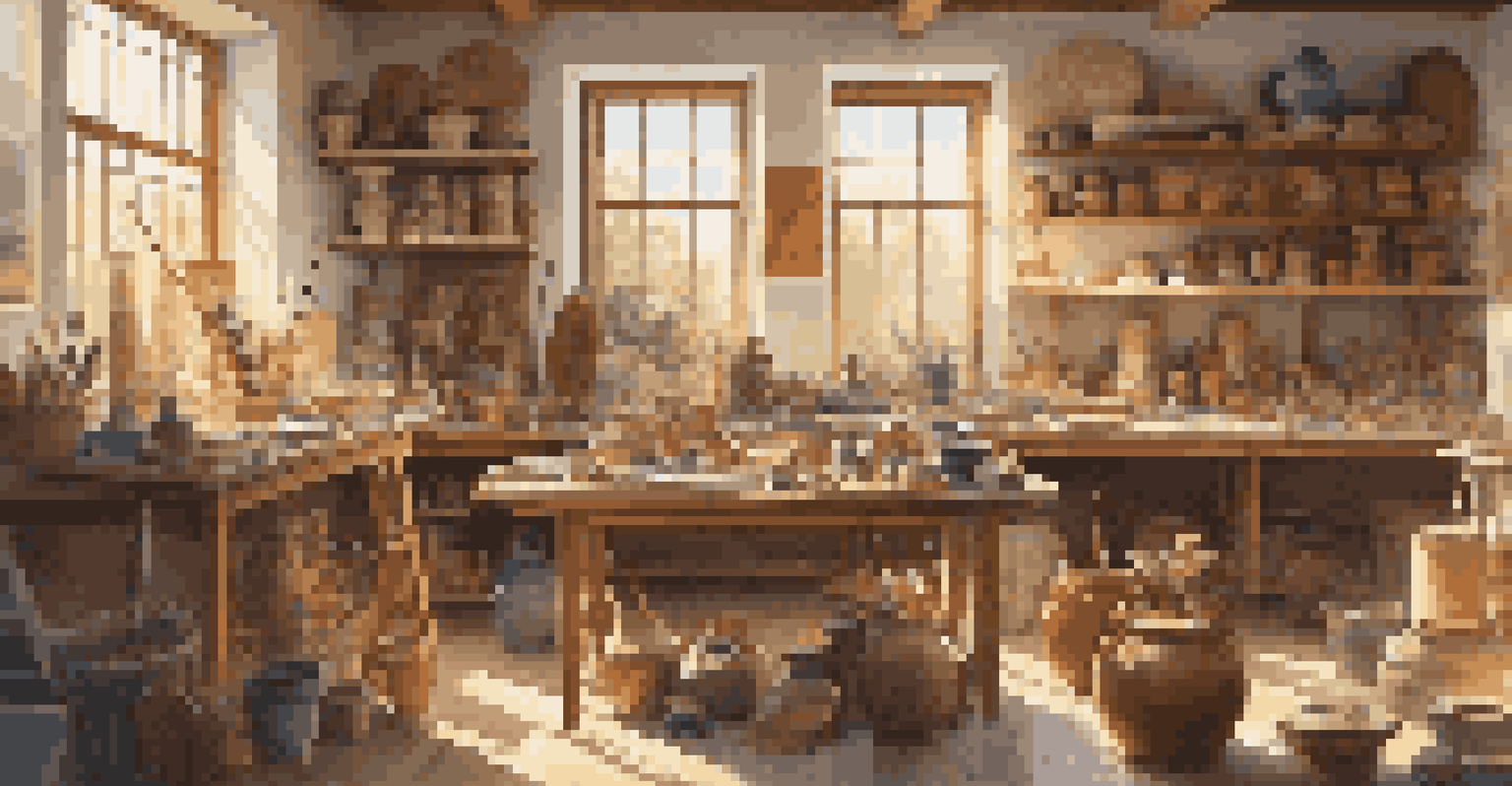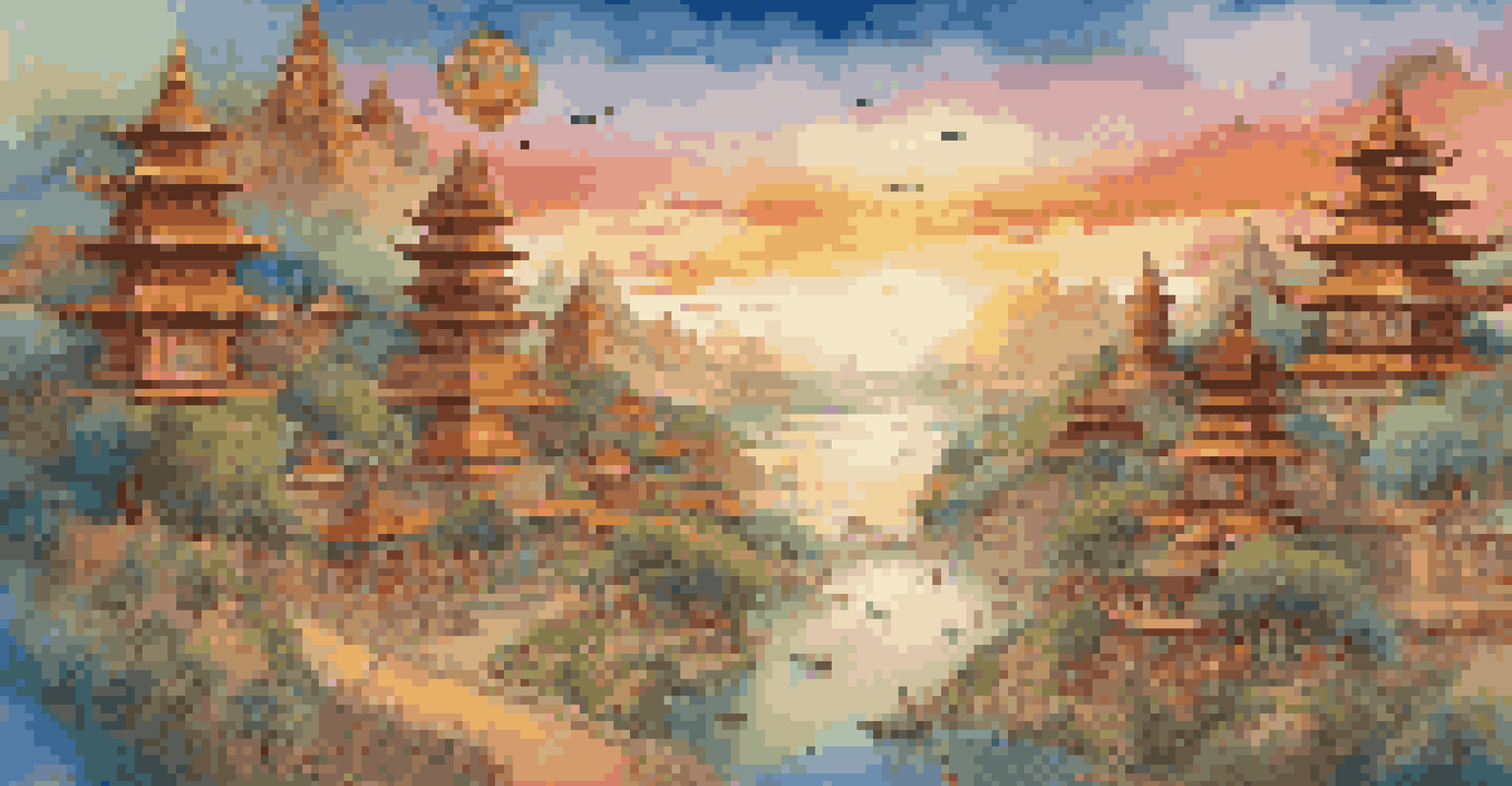The Globalization of Pop Culture and Its Impact on Art

Understanding Globalization in Pop Culture
Globalization refers to the interconnectedness of cultures and economies across the world. In the context of pop culture, this phenomenon allows for the rapid exchange of ideas, trends, and artistic expressions. Imagine a vibrant tapestry where threads from various cultures are woven together, each contributing its unique color and texture to the overall design.
Culture is the widening of the mind and of the spirit.
This blending of cultural influences can be seen in music, film, fashion, and even social media, where trends can go viral in an instant. For example, K-pop, a music genre originating from South Korea, has gained immense popularity worldwide, influencing everything from dance styles to fashion choices. This is a testament to how pop culture transcends borders and resonates with diverse audiences.
As a result, artists now have access to a broader range of inspirations, enabling them to create works that reflect a fusion of global influences. This not only enriches the art scene but also fosters a sense of shared cultural identity among people from different backgrounds.
The Role of Technology in Pop Culture Globalization
Technology has played a crucial role in the globalization of pop culture, acting as the catalyst that brings cultures together. With the rise of the internet and social media, artists can share their work instantly with a global audience. Think of platforms like Instagram and TikTok, where a single post can reach millions of viewers across the globe in just seconds.

This instant access has democratized art, allowing creators from all walks of life to showcase their talents without the need for traditional gatekeepers. For instance, independent artists can gain fame and recognition through viral content, bypassing traditional art institutions. This shift has empowered diverse voices, enriching the art world with new perspectives.
Globalization Enriches Pop Culture
The interconnectedness of cultures fosters a vibrant exchange of ideas and artistic expressions in pop culture.
Moreover, the digital landscape encourages collaboration across borders. Artists can co-create projects with peers from different cultures, leading to innovative works that might not have been possible within isolated environments. This collaboration reflects the spirit of globalization, where boundaries blur and creativity thrives.
Cultural Exchange: The Heart of Pop Culture
At its core, globalization promotes cultural exchange, which is vital for the evolution of art. When artists from different backgrounds engage with each other, they exchange ideas, techniques, and philosophies. This interaction can lead to the birth of new art forms that blend varying cultural elements, much like a potluck dinner where everyone brings their favorite dish to share.
Art is a universal language that transcends boundaries and connects us all.
For example, street art has evolved significantly as artists incorporate influences from different regions. A mural might blend traditional African motifs with contemporary Western styles, creating a dialogue between past and present. Such works challenge viewers to reconsider their preconceived notions about culture and art.
This cultural exchange also fosters understanding and empathy among people, as they appreciate the richness and diversity of global perspectives. The art produced through this lens often resonates on a deeper level, encouraging audiences to engage with the world around them in more meaningful ways.
Pop Culture's Influence on Artistic Trends
Pop culture significantly influences artistic trends, shaping how artists express themselves and connect with audiences. For instance, the rise of sustainability in pop culture has prompted many artists to explore themes of environmentalism in their work. This reflects a growing awareness of global issues, urging both creators and audiences to consider their impact on the planet.
Moreover, art forms that were once niche or overlooked can gain mainstream attention through pop culture. Take the resurgence of traditional crafts like pottery or weaving—once seen as outdated—now celebrated through social media influencers and lifestyle brands. This brings new life and relevance to these art forms while connecting them to contemporary culture.
Technology Drives Cultural Sharing
Digital platforms enable artists to share their work globally, promoting collaboration and diverse perspectives.
As artists respond to and incorporate these trends, their work becomes a mirror reflecting society's values and concerns. This dynamic relationship between pop culture and art not only drives innovation but also keeps the art world relevant and engaging.
The Challenges of Cultural Appropriation
While globalization offers many opportunities, it also raises concerns about cultural appropriation in the art world. This occurs when artists adopt elements of another culture without understanding or respecting its significance. Imagine someone borrowing a cherished family recipe but failing to honor its origins or the traditions associated with it.
Cultural appropriation can lead to the commodification of cultural symbols, stripping them of their original meaning. For instance, fashion designers may use traditional garments as mere trends without acknowledging their cultural roots, which can be hurtful to the communities from which they originate. This highlights the importance of sensitivity and awareness in artistic expression.
To navigate these challenges, artists must engage in informed dialogue with the cultures they draw inspiration from. By fostering genuine connections and promoting mutual respect, artists can create work that honors and celebrates diversity rather than appropriating it.
The Future of Art in a Globalized World
As globalization continues to shape pop culture, the future of art appears vibrant and diverse. Artists now have unprecedented access to resources, ideas, and audiences worldwide, allowing for innovative and boundary-pushing creations. This interconnectedness invites a new era of artistic exploration where cultural narratives converge and evolve.
We may see a rise in art that reflects pressing global issues, as artists draw on diverse perspectives to address societal challenges. Works that engage with themes of climate change, social justice, and identity will likely become more prevalent as artists use their platforms to raise awareness and inspire action. This evolution underscores the power of art as a vehicle for change.
Cultural Sensitivity in Art Creation
Artists must navigate the fine line between inspiration and cultural appropriation to honor the significance of different traditions.
Ultimately, the future of art will depend on our ability to navigate the complexities of globalization with respect and creativity. By embracing cultural exchange while remaining mindful of appropriation, artists can contribute to a rich tapestry of global art that resonates with audiences far and wide.
Conclusion: Embracing Diversity in Art
The globalization of pop culture has profoundly impacted the art world, enriching it with diverse influences and perspectives. As we embrace this interconnectedness, we must also recognize the responsibilities that come with it. Celebrating diversity in art means appreciating the nuances of different cultures while fostering an environment that encourages dialogue and understanding.
Through cultural exchange, artists can create works that resonate with a global audience, reflecting shared experiences and emotions. Art becomes not just a personal expression but a collective narrative that transcends boundaries, forging connections among people from different walks of life.

In conclusion, as we navigate the complexities of a globalized world, let us champion the beauty of diverse artistic expressions that inspire, challenge, and unite us all. By doing so, we pave the way for a future where art continues to thrive and evolve in harmony with the rich tapestry of human culture.